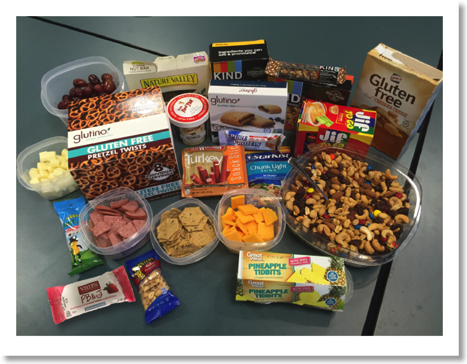Gluten-Free Communion Guide
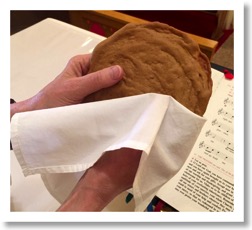
Attention to detail is critical for success in the gluten-free lifestyle. It is not surprising considering lives are turned upside-down by something measured in parts per million [yes, parts per million].
Please keep an open mind about the information presented here. It can be hard to comprehend that "The Staff of Life" can make someone sick. Science proves it to be true for about 3 million with celiac disease and an estimated 17 million with gluten sensitivities; just in the USA alone.
In this guide, you'll find information on gluten, how to eliminate gluten cross-contact, several recipes for gluten-free hosts, and links to commercially available gluten-free hosts.
If you have questions or desire additional help in instituting a gluten-free communion in your house of worship, please reach out to us.
Alan & Peggy Klapperich
Gluten Intolerance Group of East Central Wisconsin
GIG.EastCentralWisconsin@gluten.org
Phone: 920-748-4877
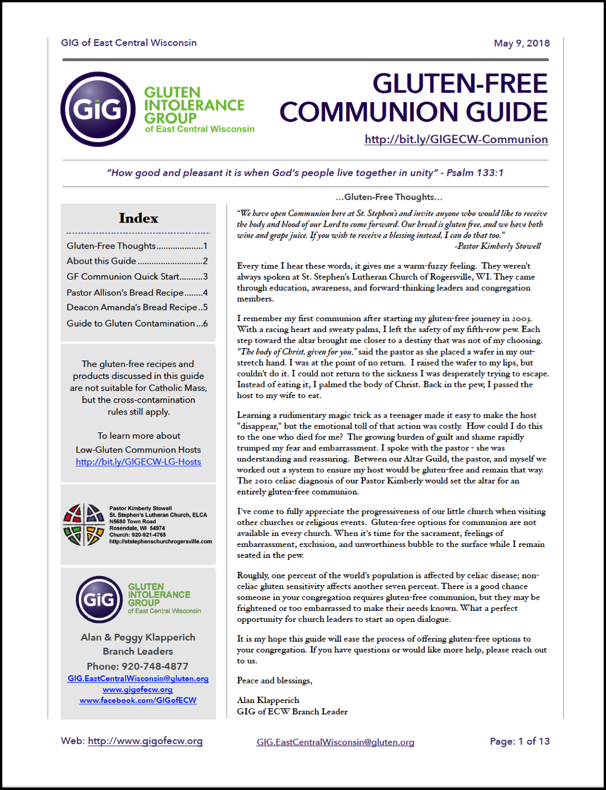
Gluten-Free Label Reading


It should be no surprise that attention to detail increases our chances of success in the gluten-free lifestyle. After all, something measured in parts per million rearranges our lives. Talk about little things making big things happen. Coach Wooden’s words take on a whole new meaning for those with a gluten-related disorder.
Knowing what's in our food is probably one of the most important details. President Theodore Roosevelt signed into law the Pure Food and Drugs Act of 1906. Known as the Wiley Act, it gave the federal government the power deem a food “misbranded” if ingredients were “false or misleading,” or deemed “adulterated” if it contained ingredients harmful to health. Sadly, it would take nearly a century before the presence of food allergens would be recognized. A decade later, gluten-free regulations finally make it on the books.
The Protection Agencies
Only a few different governmental agencies regulate food safety. In this article, we’ll be discussing the US Food and Drug Administration (FDA) and the US Dept. of Agriculture (USDA). The US Treasury’s Alcohol and Tobacco Tax and Trade Bureau (TTB) regulates beverage alcohol [as in gluten-free beer]. Sorry beer lovers, we won’t be getting into those regulations in this article.
FDA vs. USDA
The FDA regulates most packaged foods we see on the store shelves. The USDA regulates meat, poultry and egg products, and mixed food products that contain more than three percent raw meat or two percent or more cooked meat or poultry (e.g., soups, chilis, frozen entrees).
While USDA regulated products are encouraged to follow FDA regulations, it is not required. [This is valuable information to know when it comes to reading ingredient lists. More on this later.]
Estimates show that 80% to 90% of USDA products voluntarily comply. If you see a “Contains” statement or other indication of a USDA product, major food allergen will be plainly listed.
FDA & the Top 8 Food Allergens
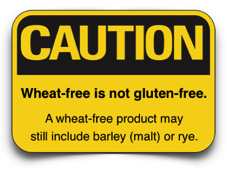
The FDA’s Food Allergen Labeling and Consumer Protection Act of 2004 (FALCPA) requires food labels to clearly identify the food source names of all major food allergens used to make the food. They must use the common or usual name of an ingredient [e.g., Modified Food Starch (wheat)} or use a “Contains” statement next to the ingredient list. [e.g., Contains Wheat, and Milk]
What are the major allergens as defined by the FDA?
- Milk
- Eggs
- Fish (bass, flounder, cod)
- Crustacean shellfish (crab, lobster, shrimp)
- Tree nuts (almonds, walnuts, pecans)
- Peanuts
- Wheat (including all types: durum, spelt, emmer, farina, farro, einkorn)
- Soybeans
Source FDA: http://bit.ly/FDA-Big8
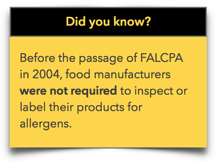
You’ll notice the Top 8 list above only includes wheat. It does not include gluten-containing ingredients barley (malt), rye, or oats*. Fortunately, barley is most commonly listed as “barley," "barley malt," or simply “malt”. Rye is rarely used in a form other than flour and would appear in the ingredient list.
*Oats (and products that contain them) that are not explicitly certified or labeled gluten-free are off-limits to anyone following a gluten-free diet. They are a high-risk ingredient because they are exposed to substantial amounts of gluten via cross-contact from field to packagings. Oats require additional knowledge and careful consideration.
 "What Oats Through Yonder Package Breaks?"
http://bit.ly/GIGECW-PureOats
"What Oats Through Yonder Package Breaks?"
http://bit.ly/GIGECW-PureOats
The Ingredient Label
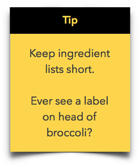
The ingredient label is your frontline defense in determining the gluten-free status of a product. An important fact to know: FALCPA labeling regulations do not apply to the potential or inadvertent presence of food allergens resulting from cross contact. Cross-contamination of a food or ingredient can occur at harvest, transport, manufacturing, or packaging. Calling the manufacturer may be required not only for ingredient clarification but also to determine manufacturing practices.
Cross-contact and Good Manufacturing Practices
Manufacturers are encouraged [not required] to follow Current Good Manufacturing Practices (CGMP). Part of CGMP means developing and executing food allergen control plans. The plan must address six elements: training of processing and supervisory personnel, segregation of food allergens during storage and handling, validated cleaning procedures for food contact equipment, prevention of cross-contact during processing, product label review and label usage and control, and a supplier control program for ingredients and labels.
Voluntary Allergen Advisory Statements
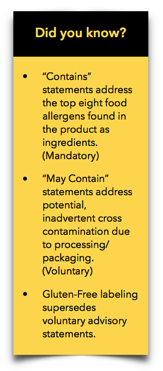
Gluten-free experts and third-party testing tell us Food Allergen Advisory statements are not useful in determining the gluten-free status of a product.
You may find a product labeled “Gluten-Free and/or Wheat-Free” or even bears a GFCO gluten-free certification logo that has a Food Allergen Advisory statement that includes wheat. Yes, this product complies with current FALCPA labeling laws.
For products not certified gluten-free, call the manufacturer to ask questions. Ask about the facilities, the production lines, and their policies, procedures for allergen handling, and testing protocols. If they do not answer the questions to your satisfaction, find another manufacturer with a similar product that does meet your needs.
 "May Contain Statements"
http://bit.ly/GIGECW-MayContain
"May Contain Statements"
http://bit.ly/GIGECW-MayContain
The Definition of Gluten-Free
As we discussed above, FALCPA does not directly address gluten. Before the FDA could create regulations regarding “gluten-free,” they needed to define what “gluten-free” means. It took ten years for the definition to finalize, but the voluntary gluten-free labeling regulation went into effect August 5th, 2014.
The FDA’s definition of “gluten-free,” “no gluten,” “free of gluten,” or “without gluten” is as follows:
“…the food either is inherently gluten free; or does not contain an ingredient that is: 1) a gluten-containing grain (e.g., spelt wheat); 2) derived from a gluten-containing grain that has not been processed to remove gluten (e.g., wheat flour); or 3) derived from a gluten-containing grain that has been processed to remove gluten (e.g., wheat starch), if the use of that ingredient results in the presence of 20 parts per million (ppm) or more gluten in the food. Also, any unavoidable presence of gluten in the food must be less than 20 ppm.”Source: http://bit.ly/FDA-QA-GF-Labeling
Notice the last sentence of the definition: "Also, any unavoidable presence of gluten in the food must be less than 20 ppm.” This means cross-contact.
I hear you…
“Whoa, this is confusing and complicated. Isn't there an App?"

Websites, published lists, and apps that report a product's gluten-free status are excellent tools to help narrow down product selection. Please do not use them as the sole means to determine the gluten-free status.
Companies change product ingredients at will, generally without notice. The product label will reflect any ingredient changes. Most companies will refer you to the ingredient list found on the product for the most up to date information. A published list (on paper or electronic form) is only as accurate as its most recent update.
Reading the label. Finally!
- Look for a third-party gluten-free certification mark - like GFCO's.
- Gluten-Free Certification Organization requires all finished products and individual ingredients using the GFCO logo contain 10 parts per million or less of gluten.
- Know your certification organizations. When companies mark their products as GF it may appear as if they are actually certified. It might simply be a logo from their marketing or package design department.
- Read the ingredient list. Yes, even certified products. If you see any of following ingredients, the product is not gluten-free.
- Wheat (including durum, spelt, emmer, farina, farro, einkorn)
- Rye
- Barley
- Oats (unless certified gluten-free)
- Brewer's Yeast
- Malt
- Ingredients needing verification:
- Yeast Extract - this could be a by-product of the beer brewing process. Verify with manufacturer in non-GF labeled products.
- Vinegar - FDA defines the single word "vinegar" to mean apple cider vinegar. However through the certification process, GFCO has encountered some usages of malt vinegar labeled as "vinegar". Remember barley/malt is not required to be disclosed. Not a large area of concern, but if you are unfamiliar with a manufacturer or product, it might be a good idea to inquire about the source of their vinegar. Better safe than sorry.
- USDA Products - Products are not required to comply with FDA's FALCPA regulations. If you see a "Contains" statement (or some other wording) that a package is complying with FALCPA, you know wheat must be declared. If you do not see a "Contains" statement, you'll need to verify the source of these ingredients (they could come from wheat):
- Starch
- Food Starch
- Modified Food Starch
- Dextrin

Congratulations!
You’ve made it! I hope I’ve increased your knowledge on this multi-layered subject.

Label Reading Resources
Gluten-Free Labels 101 Video Webinar
http://bit.ly/GIG-GFLabels101
Q&A Gluten-Free Labels 101 PDF
http://bit.ly/GIG-QA-GFLabels101
Gluten-Free Label Reading
http://bit.ly/GIG-LabelReading
3 Tips for Gluten-Free Label Reading
http://bit.ly/GIG-3TipsGFLabels
Getting Started on a Gluten-Free Diet
http://bit.ly/GIG-GettingStarted
Required Reading With Food Allergies or Celiac Disease
By: Gina Clowes
Published: April 1, 2015
Certified master life coach, Gina Clowes offers up some great labeling reading advice.
In the confusing landscape of food labels, assumptions are risky but knowledge is power.Whether you’re new to the food allergy world or a veteran, there is never a time you can let your guard down.
Read More: http://bit.ly/2H3oPW8
Updates:
04/15/18 - Added AllergicLiving.com article from Gina Clowes
Heat and the Destruction of Gluten

This question has been asked countless times over the years. Until now, we have not had any concrete answers.
All too often the gluten-free community runs into restaurants using the same deep frier for gluten items and their gluten-free items. Of course, we know this practice is not acceptable for those requiring truly gluten-free foods, but the uneducated think otherwise.
This study appearing at the International Celiac Symposium 2017 India, shows it's quite difficult to destroy gluten with temperatures used in customary cooking methods. And when it is destroyed, it's not safe to eat [not that gluten is safe to eat in its uncarbonized state...]
Rodriguez Herrera A2, Garcia Sanchez M2, Lamprea Moruno M2, Monje J3, Comino I1
1 Facultad de Farmacia, Spain, 2 IHP Group, Spain, 3 Universidad Pablo de Olavide, Spain
Background
Verify effective elimination of Gluten Immunogenic Peptides (GIP) by home cooking techniques.
Methods
Batches of samples of gluten containing flour, potatoes, and potatoes plus flour matched to controls were tested. Each batch was cooked in laboratory by use of electric stove, gas stove, oil deep fryer, induction stove and water bath and was cooked at temperature range from 91-233°C (196-452 F) for 5 up to 30 minutes. GIP content was tested by GlutenTox® Sticks (KT- 5340 Biomedal Diagnostics) based on antibody G12.
Results
On gas stove was necessary to keep 233 °C (451 °F) for 10 minutes to have absence of GIP detection.
In range 190-200°C (374-392°F) incubation for 30 minutes was needed to have absence of GIP detection. Tests in temperatures below 190°C (374°F) showed presence of GIP at 10 and 20 minutes.
On induction stove temperature up to 246°C (475°F) for 6 minutes was needed to have negativity to GIP.
Lower temperature ranges in spite of extended time up to 30 minutes were unable to get negative GIP. In oven processing never was got negative GIP signal, in spite of processing up to 210°C (410°F) and extended incubation time up to 45 minutes.
Samples processed on electric stove, water bath and deep frying showed presence of GIP in all ranges of time and temperature.
Conclusion
It is not realistic the elimination of gluten (GIP) at home kitchen by heat as temperatures higher that 200°C (392°F) are needed. Extended processing time is no compatible with conventional recipes. Fat processing over 200 is link with toxic metabolites generation which may be harmful. Use of oven or deep frying without proper cleaning may transfer GIP to meals when previously gluten containing meals were processed in these appliances.
Source: http://bit.ly/2CevzOY
Low-Gluten Communion Hosts
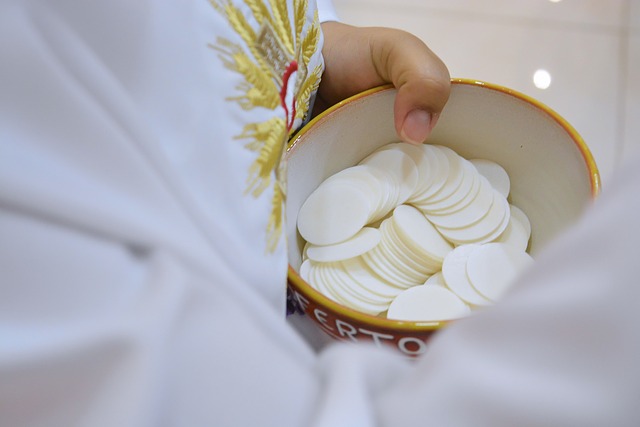
By now, you’ve probably heard the news about the Catholic Church invalidating the use of gluten-free hosts for the sacrament of Holy Communion.
Entire article: http://bit.ly/2tkolUF"
— Low-gluten hosts are valid matter for people who, “for varying and grave reasons, cannot consume bread made in the usual manner,” provided the hosts “contain a sufficient amount of gluten to obtain the confection of bread without the addition of foreign materials and without the use of procedures that would alter the nature of bread.”
— Completely gluten-free hosts continue to be “invalid matter for the celebration of the Eucharist.”
The Vatican's website: The Eucharist and Sacramental Validity, Part 1 CanonLawMadeEasy.com explains (even if a priest had celiac disease): http://bit.ly/2uLEyG9
http://bit.ly/2vptYSY
"Q: One of my fellow-parishioners has a violent allergy to wheat, so he can't receive the Eucharist under the form of bread. He has to receive from the chalice instead. Why can't priests get permission to use some other type of unleavened bread at Mass since some people have this problem? -Helene"
This news has riled up many in the gluten-free community.
It's nothing new and it has been this way for a long time. In the Catholic Church, it is impossible to consecrate anything other than wine (or mustum) and a host made of wheat and water. No priest or bishop can change 2,000 years of tradition and faith.
According to "Celiac Disease and Eucharistic Communion" by Anne Bamberg. The Jurist, 2003, 2001 (61), pp.281-289., the debate began in the 1970s. The large celiac populations of Ireland and Great Britain began asking questions of the Church.
Note from Al: I found Anne Bamberg's article very interesting. I highly recommend it. She describes celiac disease very well and shares some interesting insights into the Catholic faith.
The use of low/no gluten hosts has been reviewed by the Vatican several times over the years.
In 1995, then Cardinal Joseph Ratzinger, Prefect of the Congregation for the Doctrine of the Faith, takes up the subject in his June 19th letter to the Conference of Bishops.
The Cardinal, again validates low-gluten hosts - invalidates the use of gluten-free hosts. He also states:
"Given the centrality of the celebration of the Eucharist in the life of the priest, candidates for the priesthood who are affected by celiac disease or suffer from alcoholism or similar conditions may not be admitted to holy orders."
Yes, this means someone with celiac disease could not be an ordained priest. The Supreme Pontiff did not approve Cardinal Ratzinger's letter as it failed to seek out a favorable solution for sick or disabled persons.
In 2001, then five-year-old Jenny Richardson and her parents made national headlines for leaving the Catholic Church after Cardinal Bernard Law denied her a rice wafer for her First Communion.
In 2003, then Cardinal Joseph Ratzinger (served as Pope from 2005 to 2013), once again revisits the topic…
CONGREGATION FOR THE DOCTRINE OF THE FAITH
Circular Letter to all Presidents of the Episcopal Conferences
concerning the use of low-gluten altar breads and mustum
as matter for the celebration of the Eucharist
24 July 2003
89/78 – 17498
To their Eminences / Excellencies
The Presidents of the Episcopal Conferences
Your Eminence / Excellency:
The Congregation for the Doctrine of the Faith has been for many years studying how to resolve the difficulties that some of the faithful encounter in receiving Holy Communion when for various serious reasons they are unable to consume normal bread or wine.
A number of documents on this question have been issued in the past in the interest of offering Pastors uniform and sure direction (Congregation for the Doctrine of the Faith, Rescriptum, 15 December 1980, in Leges Ecclesiae, 6/4819, 8095-8096; De celebrantis communione, 29 October 1982, in AAS 74, 1982, 1298-1299; Lettera ai Presidenti delle Conferenze Episcopali, 19 June 1995, in Notitiae 31, 1995, 608-610).
In light of the experience of recent years, it has been deemed necessary at this time to return to the topic, taking up the above-mentioned documents and clarifying them wherever necessary.
A. The use of gluten-free hosts and mustum
1. Hosts that are completely gluten-free are invalid matter for the celebration of the Eucharist.
2. Low-gluten hosts (partially gluten-free) are valid matter, provided they contain a sufficient amount of gluten to obtain the confection of bread without the addition of foreign materials and without the use of procedures that would alter the nature of bread.
In this letter, Cardinal Ratzinger addresses a gluten-free priest's inability to receive communion, and re-worded his statement about gluten-free candidates seeking Holy Orders
3. A priest unable to receive Communion under the species of bread, including low-gluten hosts, may not celebrate the Eucharist individually, nor may he preside at a concelebration.
4. Given the centrality of the celebration of the Eucharist in the life of a priest, one must proceed with great caution before admitting to Holy Orders those candidates unable to ingest gluten or alcohol without serious harm.
Read the entire letter: http://bit.ly/2vH6I2c
In 2004, eight-year old Haley Waldman of New Jersey, had her First Communion declared invalid because a rice based wafer was used.
As one would imagine, low-gluten (not gluten-free) hosts would be a hot topic for the gluten-free community. The question becomes, how much gluten is in a low-gluten host?
When the Benedictine Sisters of Perpetual Adoration first created their Low-Gluten Altar Breads, Dr. Alessio Fasano helped test the wafers in 2004. They tested at 100 parts per million. This is 5x more than the FDA currently allows for a gluten-free product.
Ten years later, in 2014, independent testing organization Gluten-Free Watchdog was asked by a subscribing member to test the Benedictine Sisters Low-Gluten wafers. Below are the results…
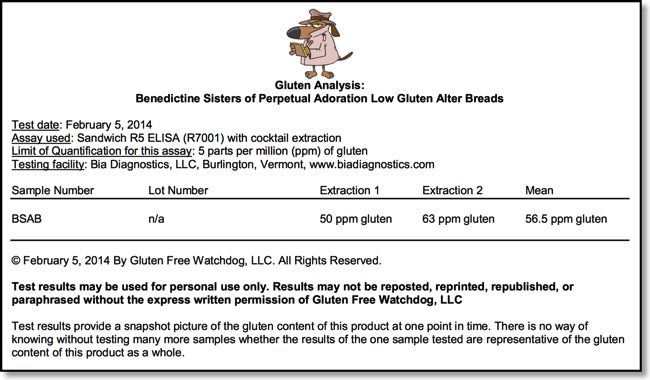
Gluten-Free Watchdog graciously granted GIG of ECW permission to share the testing results.
Thank you, GFWD for your hard work and dedication to the gluten-free community!
If you're not a subscriber, please consider becoming a member. 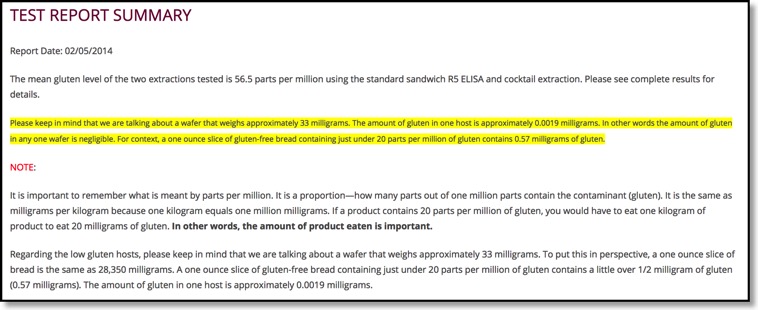
Center for Celiac Research at MGHfC Led Efforts for New Definition
http://bit.ly/2uQzqBk
As GFWD points out, parts per million is a ratio. It tells us the amount of gluten per kilogram (2.2 pounds) of food. Knowing the amount of food eaten will determine how much gluten has been consumed.
Testing reveals that a wafer weighs about 33 milligrams and contains .0019 milligrams of gluten.
Gluten-Free Watchdog provides a nice comparative:
A one-ounce slice of gluten-free bread (if it contained 19 ppm of gluten aka gluten-free according to FDA regulations) would contain roughly 0.57 milligrams of gluten.
That slice of GF bread could contain 300 times more gluten than one Low-Gluten Communion wafer.
On July 10th, 2017, two days after the Vatican issued their statement, The Benedictine Sisters of Perpetual Adoration in Clyde, Missouri issued their own statement regarding their wafers.
STATEMENT REGARDING “On the bread and wine for the Eucharist” LETTER SENT BY VATICAN AND MADE PUBLIC JULY 8, 2017
(CLYDE, Mo.) - The Benedictine Sisters of Perpetual Adoration in Clyde, Missouri, have made Vatican-approved, low-gluten altar breads since 2004. These breads have been tested by independent laboratories and deemed safe for use by many people with Celiac Sprue Disease.
The Benedictine Sisters of Perpetual Adoration were the first U.S. low-gluten altar bread producers approved by the Vatican. As early as the 1990s, the Benedictine Sisters started receiving requests for gluten-free hosts. With support from the Office of Divine Worship of the United States Conference of Catholic Bishops, the Benedictine Sisters produced a host compliant with the requirements of Canon Law and suitable for thousands of low-gluten customers around the world. These sales began in 2004, and the wafers have been approved by the USCCB for use in all U.S. dioceses.
The Benedictine Sisters are the largest religious producers of altar breads in the United States, making almost 9 million hosts each month. The low-gluten breads are produced in a separate facility in order to prevent cross-contamination. The low-gluten breads are made from water and wheat starch that has had most of the gluten removed.
In 2004 Dr. Alessio Fasano, at the time director of the the Center for Celiac Research at the University of Maryland*, maintained that the amount of gluten contained in one of the Benedictine Sisters’ low-gluten altar breads (tested at < .01 percent) was so minute that someone diagnosed with Celiac Sprue Disease would have to consume 270 wafers daily in order to reach the danger point. A test done in 2016 indicated the gluten content was even more minimal - less than .001 percent.
There are some people who are so sensitive to gluten that even the tiniest amount can cause discomfort. The Benedictine Sisters follow the recommendation set forth by the USCCB that those with such a serious gluten sensitivity discuss their condition with their pastor or Eucharistic minister. If the parish offers a separate chalice for Celiac sufferers, he or she may partake only of the Blood of Christ. It's best to avoid chalices that are used by those digesting regular altar breads because cross-contamination may occur.
More information about the Benedictine Sisters’ low-gluten breads can be found at https://altarbreadsbspa.com/low-gluten-use-storage/.
*Dr. Fasano is now with the Center for Celiac Research and Treatment at Massachusetts General Hospital in Boston.
For more information, please contact one of the following:
Tim Stiff, Altar Bread Manager
(660) 944-2227 or (800) 223-2772
tim.stiff@benedictinesisters.org
Sister Ruth Elaine Starman, OSB, BSPA General Councilor
(660) 944-2227 or (800) 223-2772
ruth.starman@gmail.com
Source: http://bit.ly/2gRaZh1
You may have noticed above I bolded "A test done in 2016 indicated the gluten content was even more minimal - less than .001 percent" .
I completely missed that upon my first read through. It's a very important sentence to the gluten-free community. The Sisters use decimal percentage numbers in their communiques instead of parts per million. For those "mathematically challenged" individuals (yeah, that's me alright!), it doesn't sink in too well.
If we do the math (What?!?! I was told there'd be no math!), we find that .001% of gluten is really…drumroll please…10 parts per million. TA DA!
On July 18th, Center for Celiac Research and Treatment issued their response in a video.
Dr. Alessio Fasano: "…provided there is some form of wheat in the wafer - no matter how much - that would be valid for communion. That’s the reason why the Benedictine Nuns produced these wafers that has 10 parts per million and they’re safe - so that definitely you have to be [?extremely religious? hard to make out those two words] to be over the threshold - in other words you’d have to take hundreds of those to be in trouble. Nothing has changed."
Pam Cureton, RD, LDN: “The wafers - that the Benedictine Sisters when they first started producing them in 2004, they were 100 parts per million. But in a recent letter they sent out on this subject, they have retested their wafers and they are less than 10 parts per million - so completely safe for those with celiac disease."
As I was watching this "disturbance in the force" play out, I was becoming more and more disheartened. People were upset with the Church, people were upset with organized religion in general. I was seeing a lot of stone casting, but no one focused on "How much gluten constitutes a low-gluten wafer?"
Making choices about ones diet is a personal matter. Factor in a spiritual practice, and it complicates the matter exponentially.
If you're not the religious type, this situation may not make much sense to you. That's fine, this is not your issue to tackle. Please feel free to move on to a more suitable topic.
If you are the religious type, particularly Catholic, this situation was likely to induce some level of stress.
Sometimes, difficult decisions must be made. I share these facts neither in-favor-of nor opposition-to, but in an effort to help others make an informed decision.
We now know a low-gluten wafer contains magnitudes less gluten than a slice of gluten-free bread.
We now know the wafers from The Benedictine Sisters might very well qualify for GFCO certification (made in a dedicated GF facility and less than 10 parts per million of gluten).
I hope these facts make it easier for someone to reconcile this conundrum.
Alan Klapperich - Branch Manager
GiG of East Central Wisconsin
GIG.EastCentralWisconsin@gluten.org
http://gigofecw.org/
http://facebook.com/gigofecw
Gluten-Free Road Trip
Alan Klapperich
Gluten Intolerance Group of East Central Wisconsin
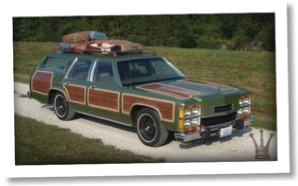
Once considered a toy for the rich and powerful, mass production methods made cars available to the general population. Since the early 1900s, this piece of machinery changed not only how we travel, but life as we know it.
There’s no denying the call of the open road. The 4 million miles of public roads in the United States offer a freedom that’s hard to match.

Most of us have childhood memories of that thing we call a “family vacation.” It involves piling everyone and only their “most essential” belongings into the family vehicle for the seemingly never-ending cross-country trek to somewhere or some obscure relative.
Traveling is one of the challenges we encounter in the gluten-free lifestyle. Leaving the safety of your home can be unsettling - even for the most experienced. With a little planning and some creativity, we can make it a trip we remember for a lifetime.
Traveling by car/van/Wagon Family Truckster/Vista Cruiser is not the fastest mode of transportation, but it’s readily accessible, the most economical, and indeed the most flexible method.
Arrive two hours before departure. Stand in endless lines. Put up with ill-tempered TSA agents eagerly waiting to do full body searches. Pay for going six ounces over the fifty-pound weight limit for luggage. Fahgettaboudit - we’re calling the shots - we’re traveling on our terms. Heck, we can take 50 pounds of shoes if we want! However, we’ll be using our space more effectively by toting 45 pounds of food and only 5 pounds of shoes. Hey, we gotta be comfortable walking around the world’s largest ball of twine, right?

A successful trip starts before you even insert the key into the ignition. Planning is an essential part of the equation - it’s even more critical on a gluten-free road trip.
I’m going to assume you’ve already had your vehicle checked over and verified its road-worthiness. No one wants a breakdown on the way Neillsville, WI to see Chatty Belle, the world’s largest talking cow.
Are you ready to start your gluten-free road trip? Let’s go!
Create an Itinerary.
Local support groups can be invaluable when it comes to finding trusted sources of food. As you well know, groups and their most humble leaders are amazing resources.
Mapping sites
- Mapping sites allow you to get directions to and from desired locations.
- Get a bird’s eye view of the area.
- Great reconnaissance tools.
- Create maps with your points of interest in order to quickly see how close or far these spots are from one another.
How far is that gluten-free restaurant from our hotel?
Google Maps
MapQuest
Bing Maps
Rand McNally
Trip Planning Websites
NOTE: No personal experience with these sites, but will be investigating them closer.
Roadtrippers
TripHobo
PlanApple
Lodging
Find, Research, and book hotel rooms. I always use TripAdvisor to vet hotels. Guest comments are constructive.
TripAdvisor
Kayak
Travelocity
We do best if we plan for breakfast and lunch. For dinner, we try to seek out a reputable restaurant - of course - if, at all possible, this is mapped out ahead of time.
Many hotels offer free continental breakfasts, but gluten-free options are usually limited to fresh fruit. If you’re lucky, you might find hard-boiled eggs. Luckily, you brought your own!
When selecting a hotel, get a room with a microwave and fridge. Having these essential tools on hand makes it a bit more convenient. If you’re staying longer than overnight, find a place with a kitchenette. Of course, this means packing some basic cooking equipment.
Stocking Your Mobile Pantry.
Since you’ve already scouted out some potential grocery stores at your stopping points, you can gauge how much food you’ll need to bring along for each leg of your Tour de ‘Merica.
Grab your favorite gluten-free crackers, pretzels, bread, snack bars, beef jerky or meat sticks, sandwich meat, packets/cans of tuna, hard-boiled eggs.
Make up a cold pasta or tuna salad the night before you leave; this makes for a great lunch the next day. While you’re at it, fry up a pound or two of bacon (crispy please). You’ll be happy you did when you have access to a microwave.
Don’t forget your favorite fruits (whole apples, bananas, oranges, grapes, watermelon, cantaloupe, strawberries) and veggies (carrots, sliced bell pepper, broccoli and cauliflower florets, celery, snap pea pods, cucumber slices, cherry tomatoes).
No road trip is complete without a big batch of trail mix (a variety of nuts, dried fruits, chocolate chips or M&Ms…and anything else you like - be creative).
Prepping some of the foods ahead of time will pay big dividends when you’re out on the road. Washing, slicing, pealing, and packaging foods will make them easier to eat. Put these foods into sealable air/water tight containers - like Ziplock Containers/bags, or Tupperware brand containers.
Toaster Bags
Practice safe-toasting. You’re hankering for a piece of gluten-free toast, but you can’t find a gluten-free toaster anywhere. No problem, toaster bags to the rescue!
Toaster Bags - Amazon
Individual/Travel Sized Products
Minimus.biz offers over 2,500 food & non-food products. A most interesting website!
Gluten-Free Food
“Only food products that have been labeled by the manufacturer as being Gluten Free are listed here in our Gluten Free Food shopping aisle. Though other products may also qualify as Gluten Free, they are not marked by the manufacturer. “
Improper food storage can result in food-borne illness; in severe cases, it can be deadly. Bacteria thrive and multiply quickly in warmer temperatures. The danger zone falls between 40 and 140 degrees. Without refrigeration or a heat source, perishable food should not be left out for more than two hours if the temperature is below 90 degrees. Reduce that time to one hour if the temperature is at or above 90 degrees. Keep cold foods at or below 40 degrees and hot foods at or above 140 degrees. Throw an appliance thermometer in the cooler to keep an eye on the temperature.
Coolers come in many sizes, shapes, and materials (soft-sided and hard sided). They range from low-tech styrofoam to hi-tech iceless car battery/AC powered travel coolers and refrigerators. The hard sided coolers offer extended cooling than soft sided. Spend some time researching which type of cooler is right for your needs - it’s worth the investment of time.
If you’re going old school with a traditional non-powered cooler, you’ll need to think about the type of ice to use. What?!? Ice is ice, no?
Crushed ice or cubes cool items faster, but blocks of ice last longer. Dry ice is also an option, but requires some special handling - we won’t cover that here.
Cube ice & water mixture is excellent for cooling beverages, but tends to be messy and doesn’t mix well with food. Soggy food is never good eats.
The best option is block ice - even better when the block is inside a container like a plastic bottle or sealable container; this helps in reducing the amount of water in your cooler.
The best bottles I’ve found are Simply Lemonade/OJ/Apple Juice/etc. 88.93 and 59 oz. Also Pure Leaf Iced Tea 64 oz. What I like about these bottles - they’re not round and have relatively flat sides - this means better contact with food for maximum cooling.
Pure Leaf Iced Tea 18oz bottles are perfect for smaller spaces. All of these bottles are made of thicker plastic and hold up very well. We use them almost weekly for grocery shopping expeditions. Soda bottles work well too.
You can also freeze water in quart sized Ziploc freezer bags or the 3” thick Ziploc rectangular containers. I’d prefer the containers over the bags. The flat ice blocks can come in handy when layering items in the cooler.
Remember, water expands when it freezes. Do not fill bottles/containers all the way to the top - leave some room for expansion.
Cooler Reviews
Looking for your first cooler? Looking to add another one to your collection? Here’s a few sites offering their reviews of different brands/models.
Good Housekeeping
Field & Stream (High End - $$$)
Outdoor Gear Lab
Best Cooler
Air & Water Tight Containers
Wondering about food storage options? Check out these containers:
LockNLock
TupperWare Brand
Food Cold Storage Times
How long can I keep foods?
Univ. of MN Extension Food Safety
Wash it before & after using. These guys usually are stored in the basement, in the garage, under the crawl space, in the attic. They can be hot and dirty. If they’re not clean and dry, the inside can get funky. No one likes Cooler Funk.
Pre-chill the cooler with ice and water mixture for a few hours before packing; this will ensure the cooler is chillin’. Discard the pre-chill ice bath.
Don’t pack room temperature or warm items. These items make the ice melt faster, plus it takes a long time for them to get cold. Make sure everything you pack in the cooler is already cold. For most food, it’ll be coming cold from the fridge or the freezer, but for things like beverages - it’s best to pre-chill them - just like the cooler.
Store foods in air/watertight containers. I mentioned this above, but it bears repeating. You don’t want cooler water seeping into your food. Ewww, just ewww. Tupperware brand containers are supposed to be the cat’s meow for this type of storage. Canning jars with the rubber-ringed covers would work too, but they’re glass and have the potential to break if dropped.
Place ice (whatever form you use) on the bottom of cooler. Place the perishable foods - those that need to be kept cold the most (pasta/potato salads, meats, dairy, eggs, etc.) closest to or directly on the ice. Build layers of ice/food/ice using those flat rectangular containers or Ziploc bags containing ice. Items on top of the cooler should require the least amount of cold.
Keep the lid closed of your food cooler as much as possible.
Have a separate beverage cooler if you have the room. A smaller one to keep a couple of bottles of your favorite beverage. It’ll help you stay out of the food cooler.
A full cooler stays colder, longer. If you start to run low on items in the cooler - add nonperishable foods, or even a blanket to take up space.
Keep the cooler out of the sun. Keep the cooler inside the car where there’s air conditioning - not in the trunk.
Find Local Gluten-Free Support Groups
Always check your destination for the nearest local support group. They’ll be able to direct you to places to shop and dine.
GIG of ECW Local Support Groups
Find Local Gluten-Free Dining
A few resources to help narrow down your dining selections.
Always ask questions and use your best discretion when dining out. If you’re not comfortable, politely leave.
AllergyEats
Gluten-Free Passport
(Smartphone app not free)
FindMeGlutenFree
Gluten Intolerance Group Links
Traveling Gluten Free
Restaurant Dining - 7 tips for staying gluten-free
Easy to Find & Fix Snacks
GF Certified Food Services
Keep all snacks in a clear tote bag or container of some type. You’ll always know where they are and you’ll be able to see which container to grab.
In the same container keep some paper towels, wet wipes, or a damp washcloth in a ziplock bag. You’ll want to wash those paws after snacking.
Salt/pepper/seasonings goes in the same container.
Non-Food Stuff.
Eating utensils - disposable or non disposable - your choice.
Paper plates/bowls/cups
Couple of kitchen knives - paring and steak knife.
Small flexible cutting board
Roll of paper towels
Trash bags
Dish soap
Simple On the Go foods:
Yogurt with granola
Hard boiled eggs
Peanut butter
Sliced cheese
Lunch meats
Meat Sticks/Jerky
Canned/Packet Tuna
Summer sausage
Crackers/pretzels/rice cakes
Granola Bars
Trail Mix
Nuts
Grapes
Protein Bars/Snack Bars
Hopefully these hints and tips have inspired you to plan your next great gluten-free adventure.
